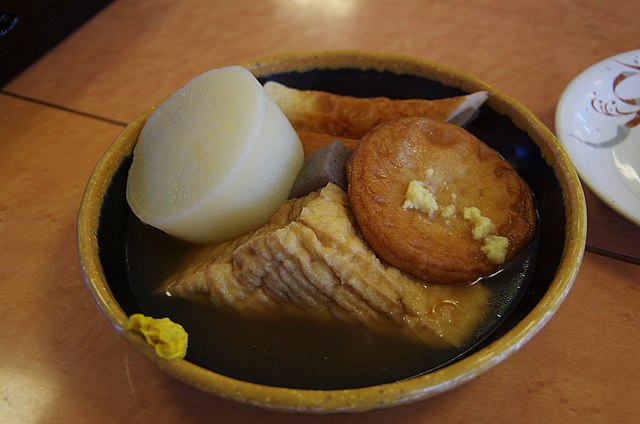Dec 27, 2023
Winter Food in Japan
As an American, there are certain foods that I look forward to when things start getting chilly. Most of those foods, like a roasted turkey or pumpkin pie, are simply not that easy to come by in Japan. So, what’s a person to do when you want something warming and hearty on a cold, winter’s day? Luckily, Japanese cuisine has it covered with a large selection of foods that are hearty, healthy and warming. And, being Japan, it is all delicious. It is so good, in fact, that winter food in Japan is something that many Japanese look forward to all year round. This is just a quick look at what can be enjoyed in this coldest of seasons.
Nabe
Not being insulated, Japanese homes tend to get cold in winter, so one of the most popular dishes is one that the whole family can crowd around to keep warm. By far and away the most popular is the hot-pot dish ‘nabe’ or ‘nabemono’ (literally ‘things in a pot’). A nabe is actually a large cooking pot, into which a variety of ingredients such as fish, seafood, meats, and vegetables can be simmered in a ‘dashi’ or broth. The dish is cooked on a gas stove around which the family can gather, taking from the bowl and adding more as they go. There are various kinds of nabe such as motsunabe that uses beef or pork with cabbage and chives, kimchinabe that utilizes the Korean spicy fermented cabbage, or yosenabe with meat, seafood, vegetables, tofu, and egg.
Shabu-shabu/Sukiyaki
Like the nabe, shabu-shabu is prepared on a gas stove in a large pot and has ingredients such as vegetables, seafood and, most commonly, pork strips. Unlike the nabe dishes, with shabu-shabu each item is cooked individually by stirring it through the boiling water or dashi, and it is from this action that the dish gains its onomatopoeic name as you swish it one way (shabu) and then the next (shabu). The cooked ingredients are then dipped into a vinegar ponzu.
Sukiyaki is a near identical dish, though the broth is a sweeter mixture of soy sauce, sugar, and mirin, and ingredients are dipped in raw egg rather than ponzu.
Oden
Another warming dish, and my personal favorite, oden is a huge winter favorite. You may have noticed it in the convenience stores in the big wooden pots near the cashier. Personally, I feel the conbini oden is not comparable on the real stuff which is slowly cooked for hours until everything is just perfect. Often sold by street vendors this dish features a variety of ingredients, such as egg, tofu, konnyaku yam cake, daikon radish, and chikawa fishcake which are stewed for hours in a soy sauce based broth.
Yakiimo
Yakiimo is, as the name suggests, baked potato. However this is no ordinary baked potato, but rather the super sweet, purple on the outside, yellow on the inside, Japanese potato. To an older generation, there is nothing to signal the coming of winter quite like the plaintive call of the yakiimo seller, wheeling his cart, singing his arrival “yakiimo, ishi yakiimo”. Nowadays you are most likely to find yakiimo at festivals or at vendors outside supermarkets, but you may still find them sold from the back of vans where they are wrapped in newspaper ready to be devoured; A creamy, sweet and a true taste of traditional Japanese winter.
Nikuman
This is the least traditional of this list, but its still a worthy addition. You see, nothing quite denotes the coming of winter in Japan like convenience stores returning the nikuman to their glass steam cabinets. Nikuman, the Japanese take on the chinese food ‘baozi’, is a steamed flour dough filled with juicy meat (though there are other flavors such as ‘curryman’ and ‘pizzaman’, the latter of which isn’t as awful as it sounds. While Nikuman can be enjoyed year round, there is something about eating one outside as it warms your hands that is just quintessentially a winter experience in Japan. With the traditional nikuman, I can recommend using a small pinch of mustard. Well worth the funny looks you’ll get!
Fugu
This last one isn’t exactly a dish that one immediately thinks of in winter, however it is something of a seasonal treat that is best tried at this time of year. Fugu, or blowfish, is famous in the west for being a deadly delicacy, but handled correctly (by chefs that have gone through many years of training), and keeping away from the poisonous liver, it is a delicious dish. In winter, there are many places at which you can enjoy a full course, starting with fugu sashimi, deep fried fugu ‘karaage’ and finally, as it is winter after all, fugu nabe. I highly recommend overcoming your fears and searching it out, as it is absolutely delicious. But as I say, ensure that you are dining at a reputable, licensed restaurant. Do not try this at home!
pelican from Tokyo, Japan, CC BY-SA 2.0, via Wikimedia Commons


About the author